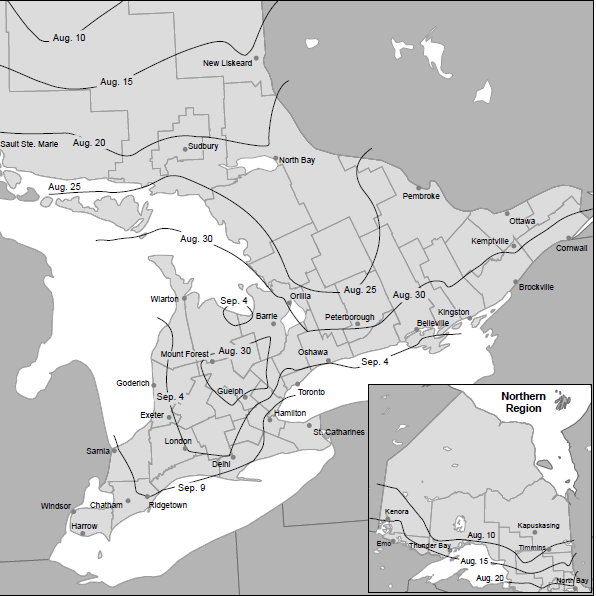Ontario Hay Listings is a free classifieds service provided by the Ontario Forage Council. Producers looking to buy or sell hay or straw are encouraged to post an ad.
Bt-resistant Corn Rootworm
Corn rootworm is a serious pest of continuous corn. Root feeding reduces yield and increases the risk of lodging and “goose-necking” which can make harvest difficult or impossible. Silk feeding can reduce kernel development. For 16 years, producers growing corn-on-corn have relied on hybrids with rootworm Bt traits (Bt-RW), sometimes called “below-ground protection”, to minimize crop damage. Since 2019, populations of corn rootworm with resistance to Bt-RW have been identified in Ontario. Crop rotation is the most effective and least expensive way to manage corn rootworm:
- For dairy, beef, and sheep farms, an alfalfa-corn rotation is simplest. The corn hybrid should not have a Bt-RW trait.
- Where rotation is challenging, a four-year rotation can be used:
- Year 1: no Bt-RW trait. Scout for adult beetles in August/September.
- Year 2: no Bt-RW trait. Soil-applied insecticide may be used if Year 1 adult population is above threshold.
- Year 3: Bt-RW trait, no insecticide.
- Year 4: rotate out of corn. This could be a winter cereal/sorghum-sudangrass double crop for silage, or a legume crop.
If producers do not implement good corn rootworm management practices, within a few years the Bt-RW traits will no longer work at all. Crop losses in corn-on-corn fields could make corn uneconomical to grow for feed, particularly silage and high moisture corn. Producers are encouraged to work with both their agronomist/crop inputs supplier and nutritionist/feed rep to come up with a crop plan to manage corn rootworm while meeting feed needs.
Agricorp Deadlines
- October 1st: apply/change summer- or fall-seeded New Forage Seeding production insurance
- November 8th: report acreage for summer- or fall-seeded New Forage Seeding
- November 22nd: pay premium for summer- or fall-seeded New Forage Seeding

South and West
- According to AAFC, Niagara, Hamilton, Brant, and part of Norfolk received below-average precipitation for August. The rest of the region received average or above-average rainfall.
- The southern-most counties will be entering the fall rest period for alfalfa in early September. See Figure 2 for average start dates.
- Six of the 10 high-risk counties for Bt-resistant corn rootworm are in this region.

Central and East
- According to AAFC, most of the region had above-average rainfall for the month. Parts of Ottawa, Lanark, and Renfrew received over twice as much rain as normal. Pockets in Durham and Peterborough had less precipitation than normal.
- Four of the 10 high-risk counties for Bt-resistant corn rootworm are in this region.
Northeast
- According to AAFC, the eastern part of Algoma and a pocket in Sudbury had below-average precipitation. The rest of the region had average or above-average rainfall for August.
Northwest
- According to AAFC, Thunder Bay had below-average precipitation. Rainy River and Kenora had average rainfall for August.
Pasture Production
Four pasture sites across Ontario are participating in a precision agriculture project to use grass more efficiently. Each week grass growth rates, among other production metrics, are measured using a rising plate meter. Average daily grass growth rates are shared publicly, while more detailed information is available to participating pasture managers.
Year-to-date grass growth rates are shown in Figure 3.

Many thanks to Living Lab – Ontario, Ontario Beef Research Centre – Elora, Victoria County Community Pasture, and la Ferme d’éducation et de recherche du Campus d’Alfred (FERCA) for their involvement in this project.